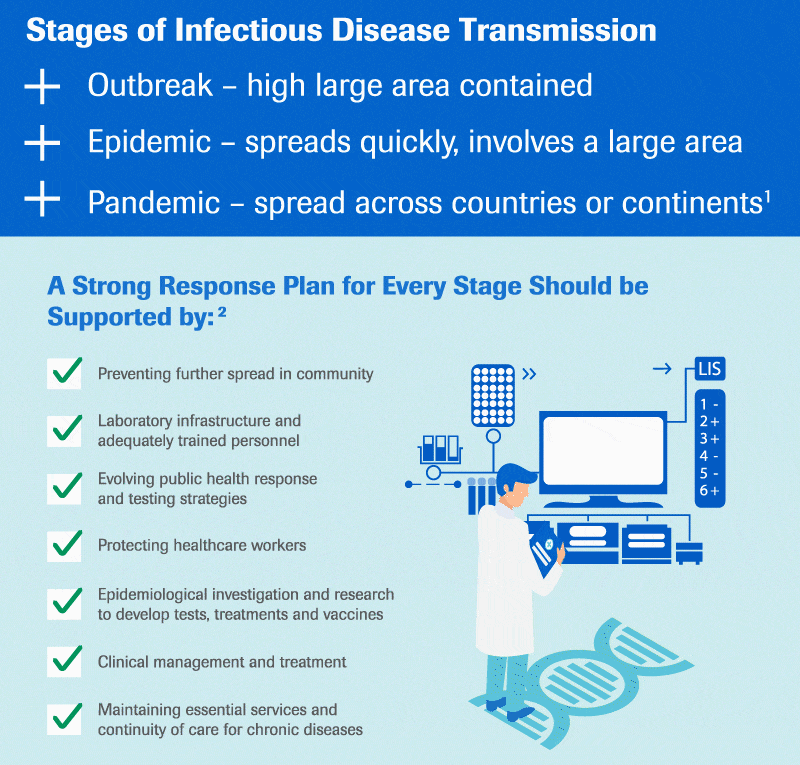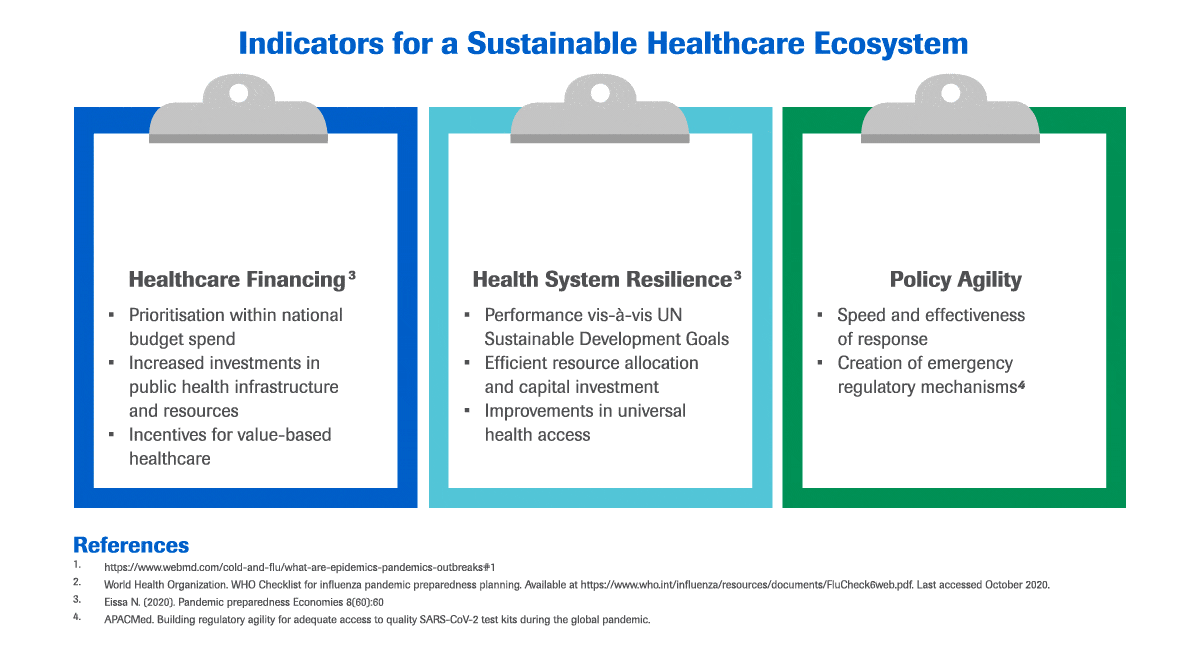Since 2009, the World Health Organization (WHO) has designated five disease outbreaks — excluding the current COVID-19 pandemic — as a “public health emergency of international concern”: Ebola (twice),1,2 swine flu or influenza A (H1N1),3 polio virus4 and Zika.5
Public health experts are understandably concerned about the frequency and velocity of these outbreaks. There are close to 200 outbreaks recorded globally each year.6 While healthcare performance indicators such as the cost of drugs and diagnostic tests, number of hospital beds or the number of patients treated have been used in the past,7 public health experts say updated parameters that consider healthcare sustainability should be used to measure the effectiveness of policies.

Chris Hardesty, who is part of KPMG’s Global Healthcare & Life Sciences Centre of Excellence, concurs. “Health investments by governments in Asia Pacific solely as a proportion of gross domestic product (GDP) can appear imbalanced when compared to the West or other developed nations. But the goal should be to improve the quality-cost equation by creating greater efficiency within the allocated funds and a heightened focus on individual accountability.”
“Take Singapore for example, which spends around 5 percent of its GDP on healthcare (half the recommended target) yet achieves life expectancy and health outcomes on par with other developed countries, in part due to creative concepts such as a nationalised Health Savings Account (HSA),” he adds.

Recent experiences have certainly heightened awareness among government leaders about the strengths and weakness of their healthcare systems. More importantly, it has emphasised the importance of government commitment to systematically strengthening health system capacity and parallel progress towards universal health coverage and global health security.8 These are core elements to ensure pandemic preparedness and achieving targets outlined in the United Nations’ Sustainable Development Goals (SDGs).
A robust preparedness framework and response capacity has proven to be a key aspect of informed decision-making in managing COVID-19. Professor Tikki Pangestu, former Director of the WHO’s Research Policy, says, “The ideal epidemic prevention and control strategy should integrate multiple components to support the deployment of appropriate resources across the different stages of a disease outbreak.”
Ramping up efforts while discontinuing chronic care services or suspending surgeries can negatively impact societal health. This is where early warning signs are critical. Specifically, he says that the core of any good infectious disease management strategy requires a strong disease surveillance mechanism. Diagnostics and testing are the starting point for disease monitoring and tracking and in guiding appropriate public health measures to control outbreaks.
Fundamental to the development of such a strategy is a well-balanced approach that focuses on three key elements:
1. Healthcare Financing
Prioritising public health spending has been shown to be a major contributor to economic growth.9 “Evolving the system into a truly fortuitous collaboration that improves population health, at a more cost-effective base, while building an industry around it has long-term economic benefits,” says Hardesty.
In a paper published in The Organisation for Economic Co-operation and Development (OECD) Journal: Economic Studies, the authors predicted that, if no additional measures are taken, the total cost of healthcare across OECD countries will almost double by 2050, reaching, on average, approximately 13 percent of GDP.10 This would place significant strain not only on health systems but also on social and economic sustainability, and could further widen health inequalities.
“Despite the ‘health-for-wealth’ mantra that has been touted for many years, the intertwine between health and economy is now very clear; countries that enable wider healthcare access will see dividends through a more productive population, even if it means shifting the way we live and work,” says Hardesty.
2. Universal Health Coverage
In advocating Universal Health Coverage (UHC) — affordable healthcare for all — the WHO points out that UHC doesn’t just save lives. It can offer protection during economic upheavals as recent instances have starkly reminded us.11 The rise of the gig economy has created a workforce that does not have access to paid sick leave or health insurance, meaning more are forced to work even when they should be staying home.
This not only creates a greater risk in the community, but also widens the wealth gap. Meanwhile, access to health services has been shown to improve health indicators and reduce poverty.11 “Equitable distribution can ensure that investment in local primary healthcare services, prevention and health promotion are not be overlooked in favour of tertiary hospital care and urban centres alone,” says Professor Pangestu. Hardesty believes every country should develop a UHC model that works within its local environment, stressing that developing countries need not simply try to play catch-up with the UHCs of developed countries, which are based on models from a century ago. “Instead they can develop their own next-generation version for the 21st century. I feel encouraged by health system designs going on in places like India, China, Vietnam and Malaysia, among others, in embracing public-private-partnership ideologies,” he says.
Read more about local healthcare trends and insights.

3. Developing the Right Infrastructure to Support Healthcare of the Future
In an outbreak scenario, digital tools are no longer a nice-to-have, but a must-have to bridge gaps in care delivery. National-level data collection presents a macro view on which larger strategic decisions about disease control can be made. This not only saves costs, but saves lives. As a 2019 WHO paper notes, “within fragile developing health systems” in particular “the availability of updated data is essential”.12
In this vein, COVID-19 has caused an uptick in digital health technology use. As the Australian Digital Health Agency notes, “Two accelerated digital health features — telehealth and electronic prescriptions — were always planned to be part of our health system. COVID-19 gave it a kick-start.”13
While COVID-19 has hastened this transition, policymakers across the region have their work cut out for them — enabling data interoperability within a secure digital ecosystem.
Crises often breed innovation. As the world looks to overcome urgent problems, solutions — old and new — have manifested in different ways. It is such innovation that will help the world, including Asia Pacific, develop and implement an effective, integrated strategy to prevent and control epidemic diseases, ultimately leading to better healthcare for all.
Read more healthcare and diagnostics news at Roche publications.
References:
1World Health Organization. (2014). Statement on the 1st meeting of the IHR Emergency Committee on the 2014 Ebola outbreak in West Africa. Retrieved from who.int/mediacentre/news/statements/2014/ebola-20140808/en/
2World Health Organization. (2019). Ebola outbreak in the Democratic Republic of the Congo declared a Public Health Emergency of International Concern. Retrieved from https://www.who.int/news-room/detail/17-07-2019-ebola-outbreak-in-the-democratic-republic-of-the-congo-declared-a-public-health-emergency-of-international-concern
3Katz R. (2009). Use of revised International Health Regulations during influenza A (H1N1) epidemic, 2009. Emerging infectious diseases, 15(8), 1165–1170. https://doi.org/10.3201/eid1508.090665
4World Health Organization. (2019). Statement of the Twenty-Second IHR Emergency Committee Regarding the International Spread of Poliovirus. Retrieved from https://www.who.int/news-room/detail/03-10-2019-statement-of-the-twenty-second-ihr-emergency-committee-regarding-the-international-spread-of-poliovirus
5World Health Organization. (2016). WHO statement on the first meeting of the International Health Regulations (2005) (IHR 2005) Emergency Committee on Zika virus and observed increase in neurological disorders and neonatal malformations. Retrieved from https://www.who.int/news-room/detail/01-02-2016-who-statement-on-the-first-meeting-of-the-international-health-regulations-(2005)-(ihr-2005)-emergency-committee-on-zika-virus-and-observed-increase-in-neurological-disorders-and-neonatal-malformations
6Huang, J. & Vendoti, D. (2019). The Fight Against Infectious Diseases: Considerations for Public Health Systems and International Cooperation, Observer Research Foundation. Occasional Paper 206. Retrieved from https://www.orfonline.org/research/the-fight-against-infectious-diseases-considerations-for-public-health-systems-and-international-cooperation-53965/
7Pourmohammadi, K., Hatam, N., Shojaei, P., & Bastani, P. (2018). A comprehensive map of the evidence on the performance evaluation indicators of public hospitals: a scoping study and best fit framework synthesis. Cost effectiveness and resource allocation. 16, 64. https://doi.org/10.1186/s12962-018-0166-z
8Chalkidou, K. & Krubiner, C. (2020). What COVID-19 Should Teach Us About Smart Health Spending in Developing Countries. Center for Global Development. Retrieved from https://www.cgdev.org/blog/what-covid-19-should-teach-us-about-smart-health-spending-developing-countries
9Raghupathi, V. & Raghupathi, W. (2020). Healthcare Expenditure and Economic Performance: Insights From the United States Data. Frontiers in Public Health. 8, 156. https://doi.org/10.3389/fpubh.2020.00156
10de la Maisonneuve, C. & Martins, J. O. (2015). The future of health and long-term care spending. OECD Journal: Economic Studies. 2014:61–96.
11World Health Organization. (2013). Arguing for Universal Health Coverage.
12Ming, D., Rawson, T., Sangkaew, S., Rodriguez-Manzano, J., Georgiou, P., & Holmes, A. (2019). Connectivity of rapid-testing diagnostics and surveillance of infectious diseases. Bulletin of the World Health Organization, 97(3), 242–244. https://doi.org/10.2471/BLT.18.219691
13Issa, S. (2020). COVID-19 intensifies the need for rapid adoption of digital health, GovTech Review. Retrieved from https://www.govtechreview.com.au/content/gov-digital/article/covid-19-intensifies-the-need-for-rapid-adoption-of-digital-health-733648124














